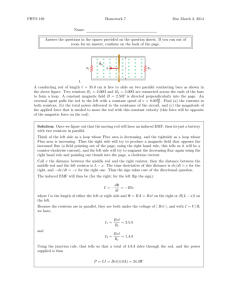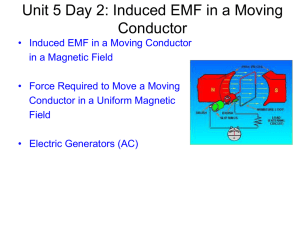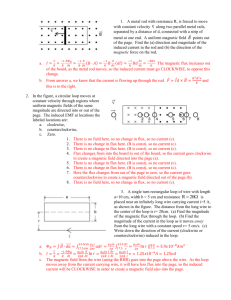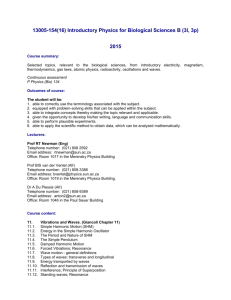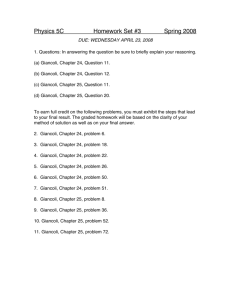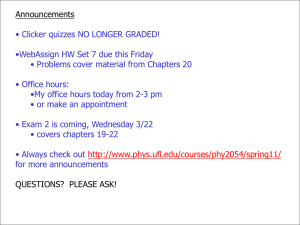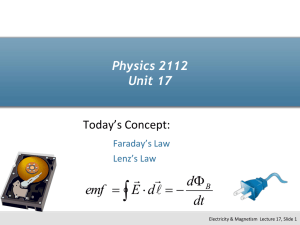PHYSICS 172
advertisement
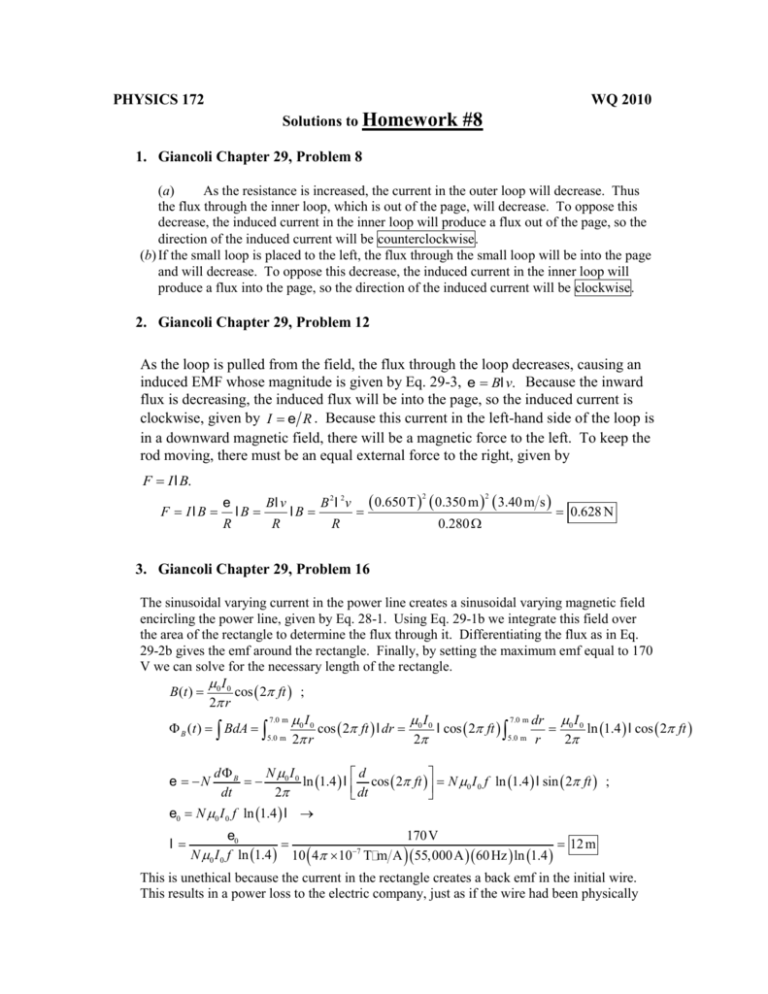
PHYSICS 172 WQ 2010 Solutions to Homework #8 1. Giancoli Chapter 29, Problem 8 (a) As the resistance is increased, the current in the outer loop will decrease. Thus the flux through the inner loop, which is out of the page, will decrease. To oppose this decrease, the induced current in the inner loop will produce a flux out of the page, so the direction of the induced current will be counterclockwise. (b) If the small loop is placed to the left, the flux through the small loop will be into the page and will decrease. To oppose this decrease, the induced current in the inner loop will produce a flux into the page, so the direction of the induced current will be clockwise. 2. Giancoli Chapter 29, Problem 12 As the loop is pulled from the field, the flux through the loop decreases, causing an induced EMF whose magnitude is given by Eq. 29-3, e Bl v. Because the inward flux is decreasing, the induced flux will be into the page, so the induced current is clockwise, given by I e R . Because this current in the left-hand side of the loop is in a downward magnetic field, there will be a magnetic force to the left. To keep the rod moving, there must be an equal external force to the right, given by F I l B. F IlB e R lB Bl v R lB B 2 l 2v R 0.650 T 2 0.350 m 2 3.40 m s 0.280 0.628 N 3. Giancoli Chapter 29, Problem 16 The sinusoidal varying current in the power line creates a sinusoidal varying magnetic field encircling the power line, given by Eq. 28-1. Using Eq. 29-1b we integrate this field over the area of the rectangle to determine the flux through it. Differentiating the flux as in Eq. 29-2b gives the emf around the rectangle. Finally, by setting the maximum emf equal to 170 V we can solve for the necessary length of the rectangle. I B(t ) 0 0 cos 2 ft ; 2 r 7.0 m I 7.0 m dr I I 0 0 B (t ) BdA cos 2 ft l dr 0 0 l cos 2 ft 0 0 ln 1.4 l cos 2 ft 5.0 m 2 r 5.0 m 2 r 2 e N dB N 0 I 0 ln 1.4 l dt 2 e0 N 0 I 0 f ln 1.4 l l d dt cos 2 ft N 0 I 0 f ln 1.4 l sin 2 ft ; e0 170 V 12 m 7 N 0 I 0 f ln 1.4 10 4 10 T m A 55,000 A 60 Hz ln 1.4 This is unethical because the current in the rectangle creates a back emf in the initial wire. This results in a power loss to the electric company, just as if the wire had been physically connected to the line. 4. Giancoli Chapter 29, Problem 20 The induced emf is given by Eq. 29-2a. Since the field is uniform and is perpendicular to the area, the flux is simply the field times the area. dB dA e B 0.28T 3.50 102 m 2 s 9.8 mV dt dt Since the area changes at a constant rate, and the area has not shrunk to 0 at t = 2.00 s, the emf is the same for both times. 5. Giancoli Chapter 29, Problem 30 The emf is given by Eq. 29-3 as e Bl v. The resistance of the conductor is given by Eq. 25-3. The length in Eq. 25-3 is the length of resistive material. Since the movable rod starts at the bottom of the U at time t = 0, in a time t it will have moved a distance vt. I e R Bl v Bl v B l vA L 2vt l 2vt l A A 6. Giancoli Chapter 29, Problem 33 (a) As the rod moves through the magnetic field an emf will be built up across the rod, but no current can flow. Without the current, v B there is no force to oppose the motion of the rod, so yes, the rod travels at constant speed. (b) We set the force on the moving rod, obtained in Example 29-8, equal to the mass times the acceleration of the rod. We then write the acceleration as the derivative of the velocity, and by separation of variables we integrate the velocity to obtain an equation for the velocity as a function of time. dv B2 l 2 dv B2l 2 F ma m v dt dt R v mR B l t dv B2 l 2 t v B2 l 2 mR dt ln t v ( t ) v e 0 v0 v 0 mR v0 mR The magnetic force is proportional to the velocity of the rod and opposes the motion. This results in an exponentially decreasing velocity. 2 2 v 7. Giancoli Chapter 29, Problem 38 From Eq. 29-4, the peak voltage is epeak NB A . Solve this for the rotation speed. epeak NB A f epeak NBA 120 V 480 0.550 T 0.220 m 9.39 rad s 1.49 rev s 2 2 rad rev 2 9.39 rad s ¬ 8. Giancoli Chapter 29, Problem 48 (a) VS VP Use Eqs. 29-5 and 29-6 to relate the voltage and current ratios. NS NP ; IS IP NP NS VS VP IP IP VS VP IS IS 120 V 0.35 A 7.5 A 5.6 V Because VS VP , this is a step-down transformer. (b) 9. Giancoli Chapter 29, Problem 50 (a) The current in the transmission lines can be found from Eq. 25-10a, and then the emf at the end of the lines can be calculated from Kirchhoff’s loop rule. Ptown 65 106 W Ptown Vrms I rms I rms 1444 A Vrms 45 103 V E IR Voutput 0 E IR Voutput Ptown Vrms R Vrms 65 106 W 45 10 V 3 3.0 45 103 V 49333V 49 kV rms 2 R. The power loss in the lines is given by Ploss I rms (b) Fraction wasted Ploss Ptotal Ploss Ptown Ploss 2 1444A 3.0 2 2 Ptown I rms R 65 106 W 1444 A 3.0 2 I rms R 0.088 8.8% 10. Giancoli Chapter 29, Problem 53 Without the transformers, we find the delivered current, which is the current in the transmission lines, from the delivered power, and the power lost in the transmission lines. P 85000 W Pout Vout I line I line out 708.33A Vout 120 V 2 Plost I line Rline 708.33A 2 0.100 100346 W Thus there must be 85000 W 100346 W 185346W 185kW of power generated at the start of the process. 2 With the transformers, to deliver the same power at 120 V, the delivered current from the step-down transformer must still be 708.33 A. Using the step-down transformer efficiency, we calculate the current in the transmission lines, and the loss in the transmission lines. Pout 0.99 Pline Vout I out 0.99Vline I line I line end Vout I out 0.99Vline 120 V 708.33A 71.548 A 0.99 1200 V 2 Plost I line Rline 71.548 A 2 0.100 1024 W The power to be delivered is 85000 W. The power that must be delivered to the step-down 2 85000 W 85859 W . The power that must be present at the start of the 0.99 transmission must be 85859 W 1024 W 86883W to compensate for the transmission line loss. The power that must enter the transmission lines from the 99% efficient step-up 86883W transformer is 87761 88 kW . So the power saved is 0.99 transformer is 185346 W 87761W 97585 W 98 kW . 11. Giancoli Chapter 29, Problem 54 We choose a circular path centered at the origin with radius 10 cm. By symmetry the electric field is uniform along this path and is parallel to the path. We then use Eq. 29-8 to calculate the electric field at each point on this path. From the electric field we calculate the force on the charged particle. d 2 dB E d l E 2 r dt B r dt r dB 0.10 m F QE Q 1.0 106 C 0.10 T/s 5.0 nN 2 dt 2 Since the magnetic field points into the page and is decreasing, Lenz’s law tells us that an induced circular current centered at the origin would flow in the clockwise direction. Therefore, the force on a positive charge along the positive x-axis would be down, or in the ˆj direction.
